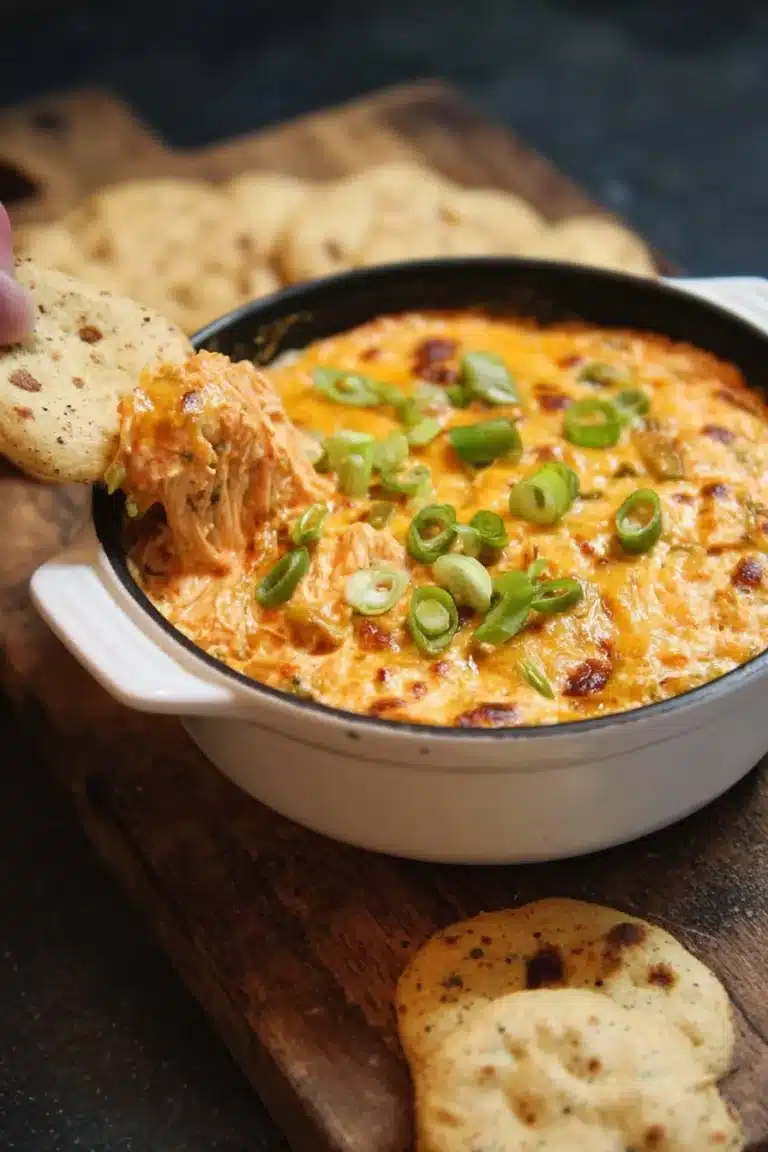
Memories on the River: Where My Love for Smoked Trout Began
The first time I fell in love with a smoked trout recipe, I was barefoot on a pine-lined riverbank. My grandfather, a man of simple tastes but rich culinary instincts, showed me how to transform our freshly caught rainbow trout into something unforgettable. We didn’t own fancy smokers or gadgets—just salt, sugar, and firewood. But the taste? It was magic. That memory became the reason I still chase the perfect balance of smoke, salt, and tenderness every single summer.
At Recent Recipe, food isn’t just about ingredients—it’s about reawakening flavor through simplicity. Our smoked trout recipe isn’t designed for show; it’s designed to bring people back to something real. Whether you’re prepping your first fish or fine-tuning your own technique, this guide walks you through the entire journey—from choosing the trout to pulling the flaky, glistening masterpiece off the smoker.
In this article, you’ll discover why this smoked trout recipe delivers more than just flavor. It delivers flexibility—dry or wet brine, fillets or whole fish, steelhead or brook trout. We’ll cover each option step by step, ensuring your smoked trout turns out perfect every time.
Print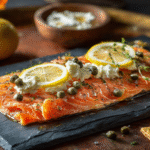
Smoked Trout Recipe That’s Packed With Flavor (Dry or Wet Brine Options)
- Total Time: 3 hours 30 minutes
- Yield: 4 servings 1x
Description
Smoked trout recipe with wet and dry brine options, smoked to perfection with mild woods. Perfect for fillets or whole trout.
Ingredients
4 trout fillets or 2 whole trout
1/4 cup kosher salt
1/4 cup brown sugar
1 tsp garlic powder
1/2 tsp paprika
4 cups water (for wet brine)
Bay leaves, pickling spice (optional)
Fresh herbs (rosemary, dill)
Maple syrup or brown sugar (for glaze)
Instructions
1. Prep trout fillets or whole trout and pat dry.
2. Mix dry brine ingredients or combine wet brine in a container.
3. Apply brine and refrigerate (4–12 hrs depending on method).
4. Rinse trout and pat dry thoroughly.
5. Place on wire rack to form pellicle (4–12 hrs).
6. Preheat smoker to 125°F, gradually increasing to 175°F.
7. Smoke trout for 2–4 hrs until internal temp reaches 145°F.
8. Optionally apply glaze in final hour.
9. Rest for 15 mins, then serve or store.
Notes
Use alder, apple, or cherry wood for best flavor.
Forming a pellicle is critical for smoke adhesion.
Smoked trout keeps 7 days refrigerated or 3 months frozen.
Serve with crackers, cream cheese, or in dips.
- Prep Time: 15 minutes
- Cook Time: 3 hours
- Category: Dinner
- Method: Smoking
- Cuisine: American
Nutrition
- Serving Size: 1 fillet
- Calories: 220
- Sugar: 5g
- Sodium: 780mg
- Fat: 10g
- Saturated Fat: 2g
- Unsaturated Fat: 6g
- Trans Fat: 0g
- Carbohydrates: 6g
- Fiber: 0g
- Protein: 28g
- Cholesterol: 70mg
Keywords: smoked trout recipe, smoked trout brine, dry brine for trout, wet brine
Why this smoked trout recipe works
What sets this smoked trout recipe apart is its versatility. Many guides lean hard into either dry or wet brines—but here, you’ll get both. And unlike one-size-fits-all techniques, we take into account the exact cut of fish you’re using, whether it’s a delicate fillet or a hearty whole trout. More importantly, we break down the science behind the method—why forming a pellicle matters, what temperature preserves texture, and which woods actually complement rather than overpower the fish.
Using either a dry brine (ideal for quick prep) or a wet brine (for deeper flavor), you’ll develop that golden finish smoked trout lovers crave. Pair it with alder or applewood, and you’re on your way to trout so tender and fragrant, it almost doesn’t need a glaze—though we’ll show you how to make one if you want a sticky-sweet finish.
This is more than a basic smoked trout recipe. It’s an approach built for beginners and seasoned smokers alike. And it’s loaded with tips the best anglers swear by—like using rosemary twigs to prop open a whole trout cavity, or how to use airflow to your advantage while forming the pellicle.
The journey from fresh catch to smoky perfection
At its core, smoking trout is a lesson in patience and precision. It starts with choosing the right trout—lake, brook, or steelhead. Then comes the prep: deciding whether to work with fillets or whole fish, applying the right brine, and most crucially, letting the fish dry until a tacky sheen forms across the surface.
That sheen? It’s called a pellicle, and it’s the unsung hero of any smoked trout recipe. Without it, the smoke won’t stick, the flavor won’t penetrate, and the result will fall flat. That’s why we don’t skip it here—and neither should you.
By the time you close the smoker lid and the wood chips begin to crackle, you’ll already know your smoked trout is on its way to becoming something extraordinary. This guide ensures every choice you make along the way—from seasoning to smoker temperature—is the right one for your exact trout, your exact taste, and your exact goals.
Ready to start? Let’s dive into the ingredients and brining methods next.
Choose Your Cut: Fillets or Whole Trout
Before you begin any smoked trout recipe, you need to choose your cut—smoked trout fillets or a smoked whole trout. Each has its benefits. Fillets smoke quickly and allow brine and smoke to penetrate evenly. They’re ideal if you’re working with rainbow or brook trout. Whole trout, on the other hand, deliver a richer, rustic flavor, especially when smoked cavity-opened with herbs inside.
For fillets, remove pin bones carefully and leave the skin on. This helps the fillet hold together while smoking and adds a crispy finish once done. Pat them dry with paper towels, removing as much moisture as possible after brining.
For whole trout, clean thoroughly and keep the head and tail intact for presentation. Insert a fresh rosemary twig, thyme sprigs, or lemon slices into the cavity. Then gently insert a wooden skewer or herb stick to prop the cavity open—this is the secret to allowing smoke to circulate deep inside.
No matter which cut you choose, your smoked trout recipe begins with the brine—and you’ve got options.
The Brine Debate: Dry vs. Wet
Every truly good smoked trout recipe starts with a proper brine. And the great debate? Wet brine vs. dry brine. Here, you’ll find a method for each—both proven, flavorful, and built for trout.
Dry Brine for Trout (Fast, Flavorful)
A dry brine is ideal when time is short. It cures the fish using salt, sugar, and spices. The salt draws moisture out of the trout, helping firm up the flesh and infuse flavor quickly.
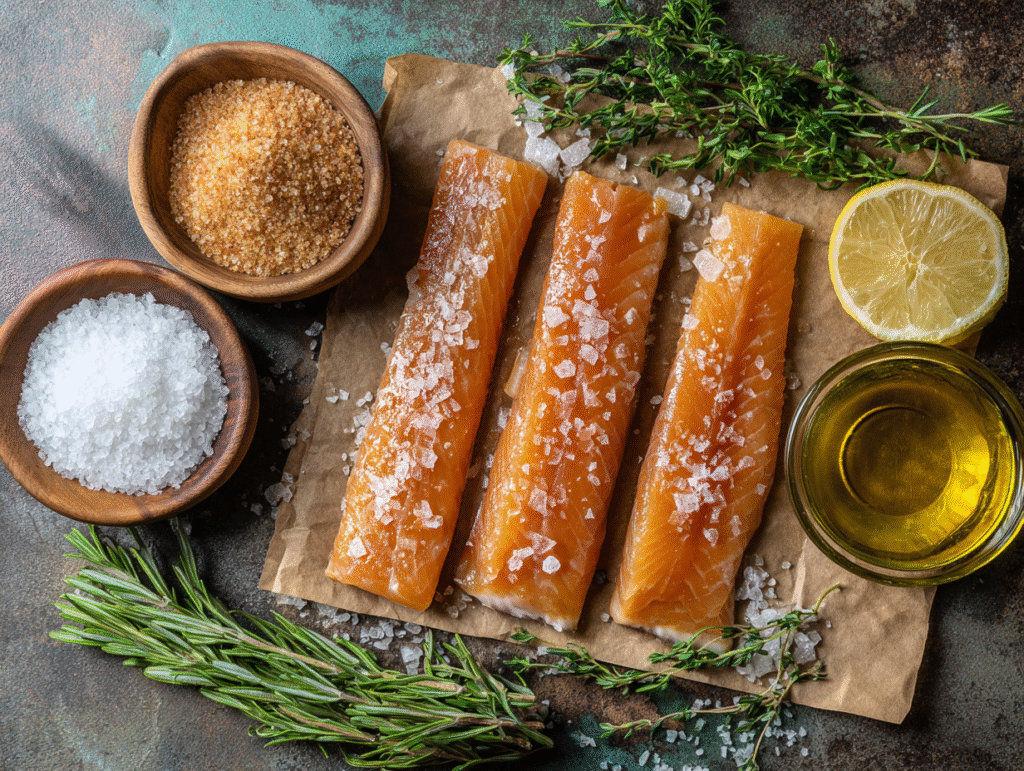
Dry Brine Recipe:
- 1/4 cup kosher salt
- 1/4 cup brown sugar
- 1 tsp garlic powder
- 1/2 tsp smoked paprika
- Optional: 1 tsp black pepper or dried dill
Instructions:
- Mix all dry ingredients in a bowl.
- Rub generously onto each fillet or the entire outside of whole trout.
- Place trout on a wire rack over a tray and refrigerate uncovered for 4–6 hours.
- Rinse lightly under cold water and pat dry thoroughly.
Wet Brine for Smoked Trout (Deeper Flavor)
A wet brine involves soaking the trout in a seasoned saltwater solution. It works best for smoked whole trout or thicker fillets like steelhead trout and smoked lake trout.
Wet Brine Recipe:
- 4 cups cold water
- 1/4 cup kosher salt
- 1/4 cup brown sugar
- 2 bay leaves
- 1 tsp pickling spice or crushed juniper berries
- Optional: garlic cloves, sliced lemon, thyme
Instructions:
- Combine all ingredients in a large non-reactive container. Stir to dissolve.
- Submerge the trout completely. Cover and refrigerate for 6–12 hours.
- Remove from brine, rinse under cool water, and dry with paper towels.
Dry Brine vs. Wet Brine for Smoked Trout
| Brine Type | Best For | Prep Time | Flavor Notes |
|---|---|---|---|
| Dry Brine | Fillets, quick cures | 4–6 hours | Bold, lightly cured flavor |
| Wet Brine | Whole trout, thick fillets | 6–12 hours | Mellow, seasoned depth |
The Pellicle: Your Secret to Smoky Perfection
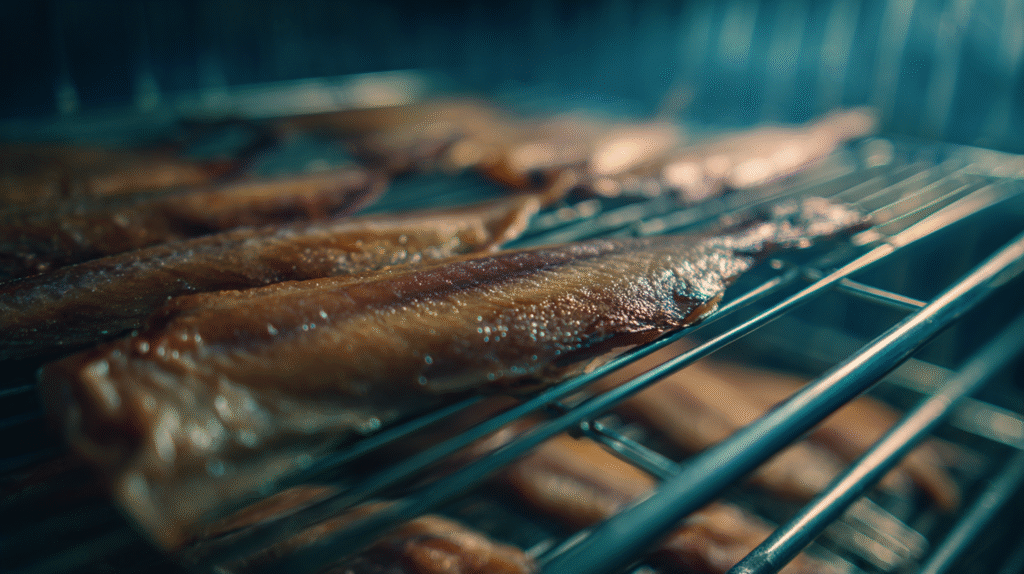
After brining, don’t rush to the smoker. Instead, let your trout breathe. This is where the pellicle comes in—a thin, slightly tacky layer that forms on the fish’s surface as it dries. It may look subtle, but the pellicle is non-negotiable in any smoked trout recipe. It acts like glue for the smoke, locking in flavor while keeping the fish moist.
Here’s how to form it:
- After rinsing off the brine, gently pat your trout dry with paper towels.
- Place the fish skin-side down on a wire rack over a baking sheet.
- Refrigerate uncovered for 4–12 hours, or leave it in a cool, well-ventilated room with a fan blowing gently.
- You’ll know it’s ready when the surface feels slightly sticky but not wet.
Skipping this step is a surefire way to end up with dull, uneven flavor—and nobody wants that. If you’re serious about flavor (and you should be), make the pellicle part of your process every single time.
Time & Temp: Smoking Setup for Trout
Now, let’s get to the fun part—smoking. Whether you’re using a pellet grill, electric smoker, or offset smoker, the fundamentals stay the same: steady low heat, gentle wood smoke, and internal temperature control.
Choosing the Best Wood for Smoked Trout
Because trout is delicate, it absorbs flavor fast. You want to avoid overwhelming the trout with strong smoke flavors. These woods work best:
- Alder – Traditional Pacific Northwest favorite; mild and earthy
- Apple – Slightly sweet and fruity, perfect for fillets
- Cherry – Adds a touch of color and subtle sweetness
- Maple – Smooth and mild, pairs well with both dry and wet brines
Avoid hickory or mesquite—they’re far too strong for fish and will mask the flavor of your beautiful smoked trout.
Smoking Methods: Pro vs. Simple

Choose your approach based on your comfort level and setup. Both methods yield delicious results.
Pro Method (For Maximum Control):
- Start your smoker at 125°F and smoke for 1 hour.
- Increase temperature to 145°F and continue for 1 more hour.
- Finish at 175°F until trout reaches 145°F internal temp.
- Total smoking time: 3–4 hours depending on size and cut.
This technique helps reduce the white albumin (the “white stuff” often seen on smoked fish) and creates a silkier texture.
Simple Method (Reliable and Beginner-Friendly):
- Preheat your smoker to 175°F–200°F.
- Smoke trout for 2–3 hours until the internal temperature hits 145°F.
- Use a meat thermometer to check doneness—don’t guess.
Keep the temperature under 225°F. Anything hotter will cook the trout too fast and can dry it out. You’re not barbecuing—you’re slow-smoking.
Internal Temperature Chart for Smoked Trout
| Stage | Smoker Temp | Time | Target Internal Temp |
|---|---|---|---|
| Pro Method Start | 125°F | 1 hr | N/A |
| Mid-Phase | 145°F | 1 hr | N/A |
| Final Phase | 175°F | 1–2 hrs | 145°F |
Optional Glaze: Next-Level Flavor
While your smoked trout recipe will shine with nothing but brine and smoke, a glaze can elevate it to something truly memorable. Glazes add shine, lock in moisture, and deliver a sweet or tangy pop that pairs perfectly with the fish’s natural richness.
Here are two optional glaze styles to brush on during the final hour of smoking:
Sweet Maple-Honey Glaze
- 2 tbsp maple syrup
- 1 tbsp honey
- 1 tsp soy sauce
- 1/2 tsp black pepper
Combine in a small bowl. Warm gently if needed. Brush lightly onto trout during the last 45–60 minutes of smoking.
Brown Sugar Cider Glaze
- 2 tbsp brown sugar
- 1 tbsp apple cider vinegar
- 1 tsp Dijon mustard
- Pinch of cayenne (optional)
This glaze adds tang and subtle heat—perfect for whole trout or fillets with stronger brines.
You can also experiment with whiskey glazes or fruit-forward versions using peach preserves or orange marmalade. Whatever you choose, go light—let the smoke and brine still do the heavy lifting.
Serving Ideas & Leftover Brilliance
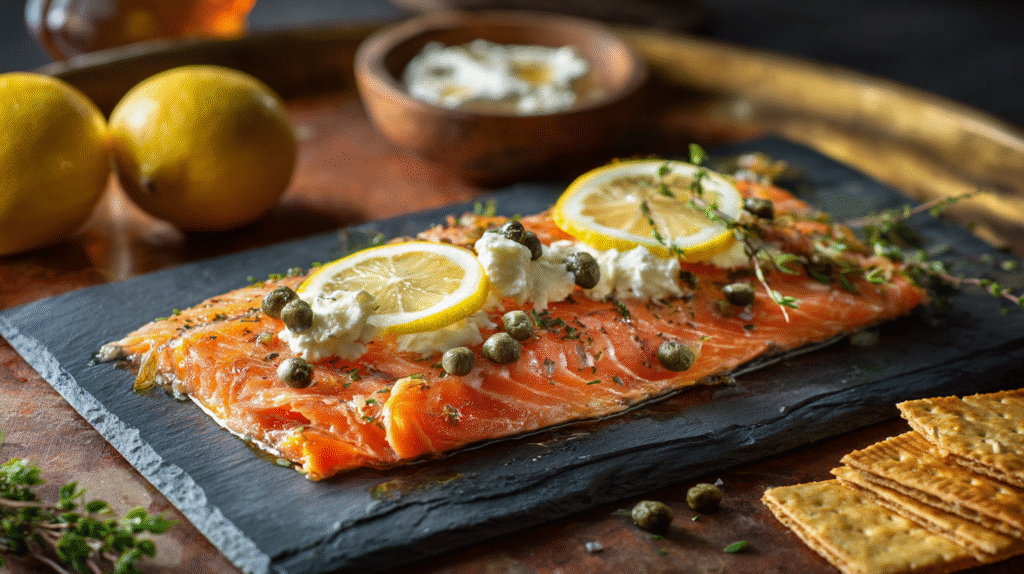
The beauty of a great smoked trout recipe is how versatile it becomes after smoking.
Serve it hot right off the smoker with roasted potatoes or grilled corn. Or chill it and enjoy it flaked over a green salad with lemon vinaigrette.
Here are reader favorites:
- On rye crackers with whipped cream cheese, red onion, and capers
- In scrambled eggs or breakfast hash
- Stirred into pasta with lemon and dill
- As a protein-packed topping for avocado toast
- Mixed into a smoky trout dip (similar to this smoked salmon dip)
The flavor is mild enough to suit all dayparts—from a rustic lunch plate to an elegant dinner starter.
How to Store and Freeze Smoked Trout
Once cooled, smoked trout keeps well if handled properly.
- Refrigerator: Store tightly wrapped in parchment and then foil. It will last up to 7 days.
- Freezer: Wrap each fillet or whole fish in paper towels, then seal in freezer-safe vacuum bags or double layers of plastic wrap. Freezes for up to 3 months.
Pro Tip: Always stuff the cavity of smoked whole trout with dry paper towels before freezing. This prevents freezer burn and preserves texture.
When you’re ready to use it, let it thaw in the refrigerator overnight. Never microwave to defrost—this ruins the delicate smoked flavor.
Table of contents
Table of Contents
How long to smoke trout for?
It depends on size and method. Fillets usually take 2–3 hours at 175°F–200°F. Whole trout may take 3–4 hours with a gradual temperature increase.
What is the best way to eat smoked trout?
Right off the smoker, flaked into pasta, chilled on toast, or served with cream cheese and herbs on crackers.
What seasoning is good for smoked trout?
Mild seasonings shine. Try garlic, dill, black pepper, paprika, or lemon zest. A pinch of cayenne adds gentle heat.
What can I make with smoked trout?
Dips, salads, scrambled eggs, pasta, trout cakes, or trout pâté. It’s incredibly versatile.
What is the white stuff on smoked fish?
That’s albumin—a natural protein that pushes out during cooking. It’s harmless, but less appealing. Reduce it by smoking slowly at low temperatures and forming a proper pellicle beforehand.
Can you freeze smoked trout?
Yes. It freezes beautifully for up to 3 months if wrapped properly. Always thaw slowly in the fridge.
This smoked trout recipe covers everything you need—from fillet to finish. Whether you’re working with smoked rainbow trout, steelhead, or brook trout, you now have the tools and flexibility to make it shine. Pick your brine, nail the pellicle, watch your temps, and enjoy the transformation of a humble fish into smoky, savory gold.




